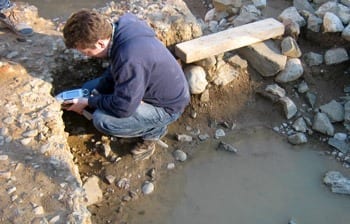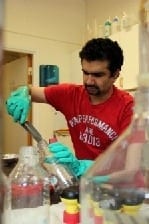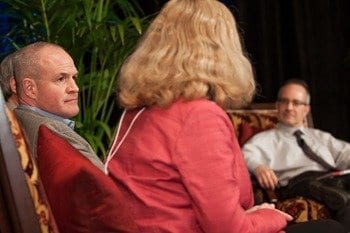
A wireless personal health monitoring system using smartphones to upload data via the Internet will revolutionize the U.S. healthcare industry, its pioneering creators say.
mHealth research at The University of Alabama in Huntsville is lead by Dr. Emil Jovanov, associate dean for graduate education and research in the College of Engineering, and Dr. Aleksandar Milenkovic, associate professor in the Department of Electrical and Computer Engineering. They have recently received funding from the National Science Foundation to develop mHealth infrastructure at UAHuntsville.
mHealth capitalizes on what Dr. Jovanov calls “major revolutions” in computer informatics, smartphones, and energy-efficient and miniaturized electronics and sensors. It can provide health information to the patient directly, to the physician via the Internet, and to researchers as aggregated databases. View the mHealth website athttp://portal.mhealth.uah.edu/public/index.php.
In 2000, Dr. Jovanov was the first to propose Wireless Body Area Networks (WBAN) for health monitoring as a sensor system to integrate sensors on or in bodies and communicate through the Internet. (E. Jovanov, J. Price, D. Raskovic, K. Kavi, T. Martin, R. Adhami, “Wireless Personal Area Networks in Telemedical Environment,” Third IEEE EMBS Information Technology Applications in Biomedicine – Workshop of the International Telemedical Information Society ITAB?ITIS 2000, Arlington, Va., November 2000, pp. 22-27).
“When WBAN is used to monitor diabetes patients using an implanted blood glucose sensor and insulin pump, the system can determine how much insulin should be released, not only based on the blood glucose level, but based on the level of activity and condition of the whole organism,” said Dr. Jovanov. “This is a fundamentally different approach made possible by the advances in technology, and we are proud that the first paper on it came from UAH.”
Dr. Jovanov said the idea sprang from the Personal Area Network used in wireless computing. “We proposed creating a personal health monitoring network within 2-3 feet from your body integrating a number of sensors to monitor your vital signs and physical activity.” Individual sensors are controlled by a smartphone that collects information from sensors and communicates with the rest of the system.
From left, Dr. Aleksandar Milenkovic, doctoral student and graduate assistant Mladen Milosevic and Dr. Emil Jovanov demonstrate one mHealth technology. The program developed at UA Huntsville uses the sensors in smart phones to monitor wheelchair use.
In collaboration with the Mayo Clinic, the researchers developed the first successful prototypes. “We were the first to demonstrate that you can create a system that is a very powerful, energy efficient and comfortable that you can wear a long time,” said Dr. Jovanov.
Since then, size and weight have shrunk and sensor and communication technologies have advanced. “It is ubiquitous wireless communication anytime, anywhere that has brought tremendous change and will improve our lifestyles tremendously in the future,” Dr. Jovanov said, citing two examples where mHealth could help.
“The more you exercise, the better you recover after a stroke, but you also can overdo it,” he said. “The smartphone-based application can motivate users to exercise more, or warn them if they are straining themselves.
“Now in heart attack, the recovery rate also depends on exercise, but often people are worried about that because they have been through this traumatic event and they don’t want to get too far away from the phone or help or they are afraid to be active again,” he continued. The mHealth system alleviates fears by its ability to detect trouble and summon help. It also can advise the heart patient when he or she is at the optimal exercise level.
The Latest Bing News on:
Personal health monitoring
- BobiHealth Launches Personalized Pregnancy Monitoring and Alert System Designed to Revolutionize Maternal Care and Support Health Care Equityon May 2, 2024 at 7:00 am
BobiHealth, a mobile application launched today, is set to transform the way pregnant women monitor their health by delivering users and their caregivers detailed insight into the mother’s health, ...
- Eazeye Radiant TRLCD monitor – better than e-paper? A Reviewon May 1, 2024 at 10:22 pm
If you think only the E Ink display provides you with the best possible eye protection against digital burnout, you are in for a surprise. This new class of displays, named the RLCD, offers most of ...
- Medical Guardian Acquires MobileHelp, Expanding Senior Health Care Solutionson May 1, 2024 at 4:58 am
Medical Guardian today announced that it has acquired MobileHelp from Advocate Aurora Enterprises to broaden its suite of health care solutions supporting aging adults with living independently and ...
- A step forward for self-health monitoring—wireless charging through a magnetic connectionon April 30, 2024 at 9:43 am
Zheng Yan and a team of researchers at the University of Missouri have made a significant breakthrough in their ongoing development of an on-skin wearable bioelectronic device. Yan's lab, which ...
- He went into a public toilet. He came out with a health checkon April 27, 2024 at 11:23 am
In China, urinals in public restrooms use technology to offer men instant health checks. The convenience is unbeatable, but what about privacy?
- Health Analytics Firm Reports Breach Affecting 1.1 Millionon April 25, 2024 at 5:00 pm
A Maine consulting firm with a medical data analytics business must notify more than 1 million Americans that hackers stole their information from company servers.
- Advocate Aurora to sell remote patient monitoring companyon April 25, 2024 at 11:54 am
Advocate Aurora bought MobileHelp in April 2022, but said the company no longer fits its strategic priorities.
- UnitedHealth says hackers accessed personal dataon April 23, 2024 at 10:43 am
UnitedHealth Group said it found files containing protected health information and personally identifiable information "which could cover a substantial proportion of people in America" following a ...
- UnitedHealth reveals hackers may have stolen large number of Americans' personal infoon April 23, 2024 at 9:23 am
The cyberattack earlier this year disrupted payment and insurance claims processing around the country, stressing doctor’s offices and health care systems.
- UnitedHealth Group: Patient data compromised despite paying ransomwareon April 23, 2024 at 8:39 am
The analysis includes monitoring the dark web and Internet to see if anyone's breached data was published. It also is utilizing information from 22 screenshots of alleged personal health and ...
The Latest Google Headlines on:
Personal health monitoring
[google_news title=”” keyword=”personal health monitoring” num_posts=”10″ blurb_length=”0″ show_thumb=”left”] [/vc_column_text]The Latest Bing News on:
Health monitoring
- BobiHealth Launches Personalized Pregnancy Monitoring and Alert System Designed to Revolutionize Maternal Care and Support Health Care Equityon May 2, 2024 at 7:00 am
BobiHealth, a mobile application launched today, is set to transform the way pregnant women monitor their health by delivering users and their caregivers detailed insight into the mother’s health, ...
- Monitor says jail still understaffed for mental health careon May 2, 2024 at 12:00 am
The St. Thomas jail is still failing to provide mental health counseling, according to a court-appointed independent monitor, who testified Tuesday that more staff are needed to adequately treat detai ...
- Aspira Women’s Health Enhances its Commercial Offering with the Formal Launch of Longitudinal Monitoring Feature of OvaWatchon May 1, 2024 at 10:00 pm
“We are proud to be able to meaningfully enhance the OvaWatch offering with the longitudinal monitoring feature,” said Dr. Sandra Milligan, President of Aspira Women’s Health. “More than 1.2 million ...
- YMCA program to help patients monitor blood pressure, eat healthy and exerciseon May 1, 2024 at 5:13 pm
GREENVILLE, S.C. (FOX Carolina) - The YMCA of Greenville has designed a new, signature program to help patients combat high blood pressure. Their evidence-based model features personalized support for ...
- Unlocking the Power of Smartwatches: Revolutionizing Health Monitoringon April 30, 2024 at 3:05 pm
Staying on top of our health is more crucial than ever. Fortunately, advancements in technology have led to the creation of smartwatches with unparalleled capabilities in health monitoring. These ...
- A step forward for self-health monitoring—wireless charging through a magnetic connectionon April 30, 2024 at 9:43 am
Zheng Yan and a team of researchers at the University of Missouri have made a significant breakthrough in their ongoing development of an on-skin wearable bioelectronic device. Yan's lab, which ...
- Blood glucose monitoring tipped to arrive on Galaxy Watch 7 - but don't get your hopes upon April 29, 2024 at 7:12 am
A new report has suggested the Galaxy Watch 7 will feature non-invasive glucose monitoring via artificial intelligence. But will this actually come to fruition?
- Sibel Health gets Gates Foundation grant for maternal monitoringon April 29, 2024 at 3:16 am
The foundation that helped launch the Northwestern spinout for wireless monitoring of mothers and babies is chipping in another $17.5 million.
- Samsung may bring blood sugar monitoring with Galaxy Watch 7on April 26, 2024 at 4:49 am
Samsung‘s upcoming smartwatches may bring a revolutionary health feature. According to the Korean media, the Galaxy Watch 7 series will boast noninvasive blood sugar monitoring capabilities. The new ...
- Don't just track your steps. Here are 4 health metrics to monitor on your smartwatch, according to doctors.on April 26, 2024 at 2:00 am
Are you using your smartwatch to the fullest? Here are 4 metrics doctors say can be useful to track beyond your daily step count.
The Latest Google Headlines on:
Health monitoring
[google_news title=”” keyword=”health monitoring” num_posts=”10″ blurb_length=”0″ show_thumb=”left”]










